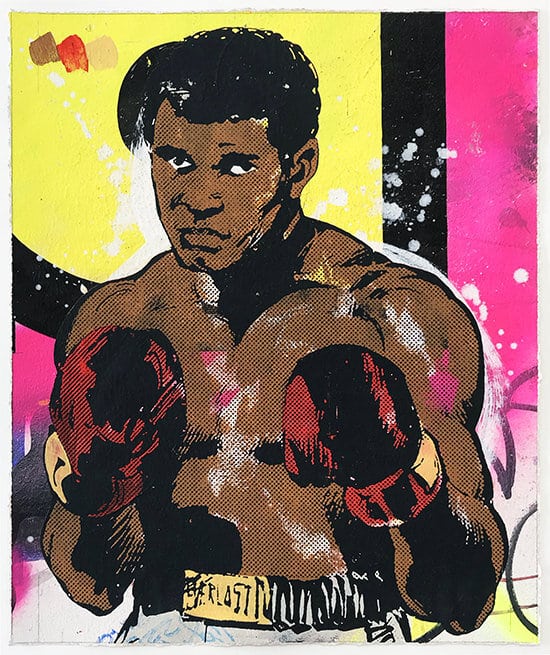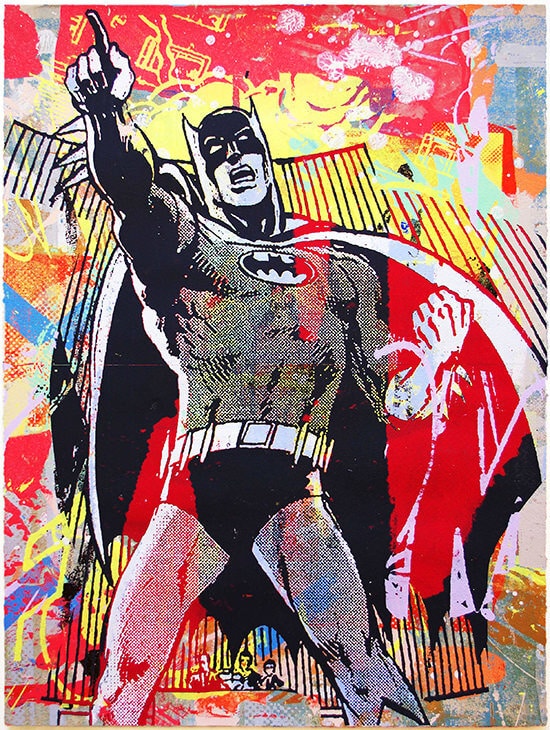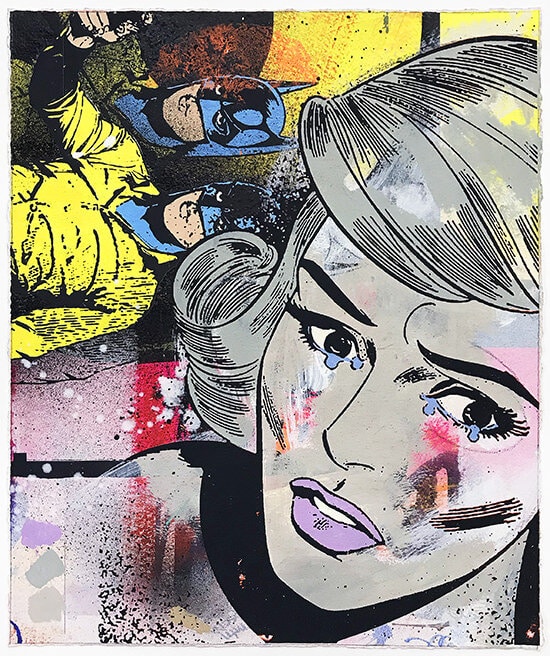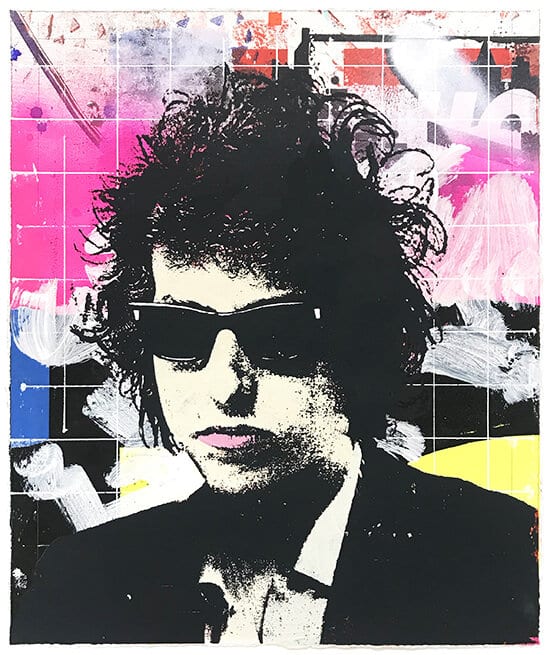
Your style utilizes very prolific pop culture icons from film, comic books, politics, sports, etc. When creating works, what message do you intend to send when building upon the chosen motifs?
Often when I create work, I don’t necessarily create it with an exact message that I’m trying to impart to the viewer. Instead, I’m often trying to create some room for them to interpret it in their own way, given their own life experience and what they’re bringing to the table. There are certainly loose directions that I am at or things that strike me in the moment when I’m creating the work. Often, I like to offer my work as more of a question to the viewer than necessarily a direct statement for them to absorb.
The nature of your art is very layered and colorful. Can you divulge any details on how you create your works?
When I go about creating work, it’s really pretty intuitive spontaneous process. Generally weaving in and out of different mediums, often that involves collage and screen-printing and hand painting and what not. So sometimes the subject matter will help push me in a certain direction, but often it’s just more of a feeling at that time and sometimes kind of a rebellion against what I’ve just done. Often times, when I create an exhibition it’s kind of getting that idea out, and maybe for that exhibition, it’s something very precise and bright colored and crisp. And then after that’s out, I tend to want to swing the other way and do something that’s more gritty, more layered, more monotone, things like that.

Speaking of color, there is a lot of variety in texture and chromatic tones that appear clashing in the best of ways, very complementary and harmonious. How do you achieve this and at what point in your process do you find it satisfactory/complete?
In terms of palette, I’m a firm believer in that there’s no bad palette it’s just a matter of finding the right subtleties. So sometimes the first 3 colors are just not a very aesthetically pleasing palette but the fourth one might bring it all together. Every color I use is all hand mixed, I’m never really pulling anything out of a tube or jar. Again it is also an intuitive process. I’m always cycling through palettes so that kind of tends to keep things fresh and that’s how there is so much variety through the years.
Color is really important to me so it’s something I’m always experimenting and trying to figure out new ways as far as opacity and layering and how everything reacts with one another. The second part of when I know something is done, I try to adhere to the principle when a further addition does not make it any better. That is when it’s done. Which leaves the definition fairly open but when you feel that the next layer isn’t making the piece stronger, it’s probably taking away from it, you know, so sometimes that can be something that’s more minimal or and sometimes that can be something more heavily layered.
The large scale works you create are very impressive, how has the process of creating those differed from your usual prints or wooden panel works?
I love working on a large scale of murals. I would say the biggest difference in terms of mural work is certainly the creative process is important, but with murals, it’s also the logistics because every environment is different. You’re dealing with weather, a lot of times in new buildings so it’s construction zones and you’re just in the mix with construction and fitting in your working windows and your lifts and all these sorts of things.
It’s a big logistical puzzle to solve in addition to the creative aspect. The creative aspect all happens ahead of time, you plan the wall, that’s all dialed in then it’s a whole new project that’s a bit of a construction project in a sense as far as logistics go. But I enjoy it, it’s nice to get out of the studio, I love working outside. And I really like working at that large scale and it’s cool because the murals can inform the studio work and vice versa so jumping back and forth is fun and keeps things fresh.

What can you tell us about your upcoming exhibitions in Chicago & Palm Springs?
The one in Palm Springs is actually up right now, we just opened that a couple weeks ago, that was a more portrait-based show, heavily pop-influenced. I’ve done portrait work on and off throughout my career and in terms of timing, it felt an inspired time to do a portrait series. It’s kind of a pop portrait-based exhibition that’s up for a couple more weeks here.
And Chicago will be next year with Vertical Gallery who I’ve shown with a few times, I believe this will be my fourth solo exhibition down there. Great gallery that I really enjoy working with, still figuring out the details as to what we’re gonna do there. A lot of the time it’s that same intuitive process and what leads up to it. It usually takes me 2-3 months to create an exhibition so beginning of next year I’ll start working out the plans there but it’s always fun to show with those guys in Chicago.
You grew up in Wisconsin and moved to Minnesota where you currently work from. How has living in the Midwest influenced your work?
I’m actually back in Wisconsin now, funny enough within the past year. I grew up in a pretty rural area and took a design job, that’s what I have my degree in. So I worked as a graphic designer for a bit in Minneapolis, Minnesota and then transitioned into my own personal work from there and then had my studio in Minneapolis for about 10 years. Then just recently moved back to Wisconsin into the rural life again.
As far as influencing my work, I feel like I’ve been able to see both sides of the coin as far as rural American and urban America. There’s benefits and negatives to both, you know, I think I’ve had an interesting perspective not living in just one my whole life and there’s definitely a tranquility being out of the city and in more in that rural landscape. I don’t know on what conscious level how I’ve necessarily put that into my work but I think it’s definitely subconsciously maybe opened things up a bit, being back out of the city.

What are your thoughts on how art has evolved over the years, specifically with a nod towards the more retro gestures you incorporate with your fresh/individualized style you meld it with?
Definitely I draw a lot of inspiration from the heyday of pop art, certainly abstract expressionism as well. Rauschenberg being my #1 influence I would say, at least when I got started, Rauschenberg is kind of what really moved the needle for me and got me interested in shifting from a strictly designed based work to what I could do on a canvas, so I guess for me, I’m always trying to explore both worlds. I like to use traditional means as far as staying off the computer as much as I can and doing things by hand and using those same processes used 60 years ago while at the same time trying to stay fresh and impart contemporary themes and the things that are going on right now in society and my life. For me, that evolution has been trying to explore both avenues that history and the contemporary and in a way that’s why my work looks the way it does because it’s that constant sense of layering and history and pushing and pulling. So things feel like the right mix.
In your bio it mentions that your work both “features and condemns pop culture.” Can you extrapolate on this point and what is your ideology behind using pop culture as a basis for creating art. Is there any part of pop culture that should be celebrated?
This kinda goes back to my comment on not wanting to necessarily to offer a specific narrative or a directed viewpoint with any particular work and that goes with trying to reflect and reference pop culture. I try to use my work as more of a mirror than necessarily a commentary. So I don’t think any aspects are 100% bad or 100% good, that really goes with most everything. So instead I’m trying to reflect ourselves and our society now and our society 50 years ago in this mash up, reflect it back upon myself and in turn the viewers and see how that looks, I suppose, for both myself and the viewer. And that changes over time too after creating the work, bits of pop culture and things I referenced maybe 10 years ago in my work – I look upon differently now than I did then. So I guess that’s where the feature in condemning is, it’s trying to offer that mirror back and let myself and the viewer parse it out as we go.

INFORMATION
All images with courtesy of Greg Gossel

